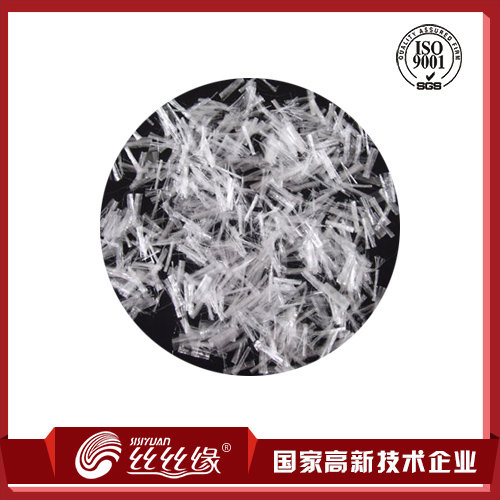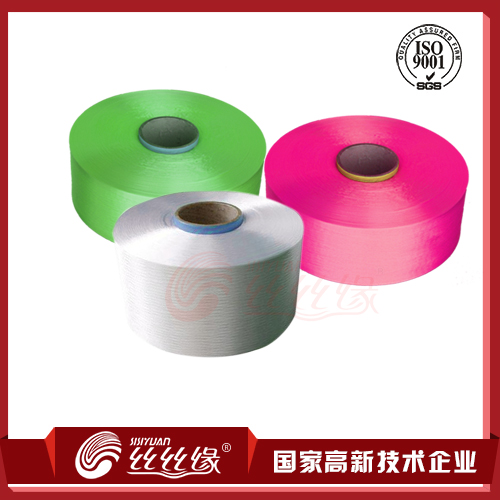
12 kinds of chemical fiber knowledge Daquan, chemical fiber must be!
1, filament
In the manufacture of synthetic fibers, spinning fluid (melt or solution) by spinning and forming process after the process, the resulting length of kilometers of fiber called filaments. Filaments include monofilament, multifilament, and cord filaments.
1
Monofilament
Originally refers to single-hole spinneret spinning made of a single continuous fiber, but in practice, often also consists of 3 to 6 holes spinneret spinning into 3 to 6 single fiber composed of small hole wire. Thicker synthetic filaments (0.08 to 2 mm in diameter) are known as bristles and are used to make ropes, brushes, daily net bags, fishing nets or industrial filter cloths; finer polyamide monofilaments for making Transparent socks or other high-level knitwear.
2
Multifilament
By the dozens of single-fiber yarn. The multifilament of chemical fiber generally consists of 8 to 100 single fibers. Absolutely
Most of the fabric weaves are made of multifilament yarns, since the multifilaments composed of multiple filaments are more compliant than the monofilaments of the same diameter.
3
Cord wire
From more than 100 root to hundreds of single-fiber composition for the manufacture of tire cord fabric, commonly known as cord wire.
2, short fiber
Chemical fiber products are cut into a few centimeters to more than ten centimeters in length, this length of fiber called short fiber. According to cut off
The length of the short fiber can be divided into cotton short fiber, wool short fiber, medium and long staple fiber.
1
Cotton short fiber
Length of 25 ~ 38mm, fiber smaller (linear density of 1.3 ~ 1.7 dtex), similar to cotton fiber, mainly used for blending with cotton fibers, such as cotton polyester staple fiber and cotton fiber blends, the fabric Known as "polyester-cotton" fabric.
2
Type staple fibers
Length of 70 ~ 150mm, thick fiber (linear density of 3.3 ~ 7 .7dtex), similar to wool, mainly used for blending with wool, such as wool polyester short fiber and wool blended, the fabric called " "Fabrics.
3
In the long fiber
Length of 51 ~ 76mm, the thickness of the fiber between the cotton and wool-type (linear density of 2 .3 ~ 3. Dtex), mainly used for weaving long-fiber fabric.
In addition to short fiber blended with natural fibers, but also with other chemical fiber short fiber blended, the resulting blended fabric has a good overall performance. In addition, the staple fibers may be pure spun. In the current world production of chemical fiber, the yield of staple fiber is higher than the yield of filament. According to fiber characteristics, some varieties (such as nylon) to produce filament-based; some varieties (such as acrylic) is the production of short fiber-based, while some varieties (such as polyester) the ratio is close.
3, coarse and fine silk
Thick and thin wire referred to as T & T silk, from its appearance can be seen alternately on the thick section and the details of the section, and silk stained and then see the alternating light and dark color changes. The coarse and fine yarns are produced by non-uniform drafting technology after spinning. The difference of the two parts of yarns in production can be controlled in production, and the distribution is irregular and in a natural state.
Thickness of coarse and fine silk section of the low strength, elongation at break, heat shrinkage, good dyeing, and easy to reduce the amount of alkali processing, can take full advantage of these characteristics of the development of unique textiles. Thickness of the physical properties of the fine details of the ratio of diameter and diameter and other factors. General thick and fine silk has a higher elongation at break and boiling water shrinkage and lower fracture strength and yield. Its strong contraction properties can make the coarse and fine silk and other wire mixed into different shrinkage mixed filament. In addition, thick and thin sections of coarse silk section is easy to deformation, low strength problems should be weaving, dyeing and finishing process to be noted. The first thick and thin wire was round wire. With the development of coarse and fine silk production technology, some special coarse and fine silk were appeared one after another, such as coarse thick filament, mixed thick filament, micro porous thick fine silk and fine denier coarse Details of silk, etc., or they have a special feel and style, or has a special suction, and more for the development of high-grade fabric.
4, textured yarn
Textured yarns include all textured yarns and yarns, such as stretch yarns and expanded yarns, as textured yarns.
1
Elastic wire
That is, deformation of filament, can be divided into high-elastic wire and low-elastic wire two. The stretch yarn has good stretchability and good bulkiness, and its fabric is close to wool, silk or cotton fabric in terms of thickness, weight, opacity, coverability and appearance characteristics. Polyester stretch yarn for the majority of clothing, nylon stretch yarn suitable for the production of socks, polypropylene stretch yarn is used for the majority of home textiles and carpets. The deformation methods are false twist, air jet, hot air jet, stuffing box method and forming method and so on.
2
Expanded yarn
That is, the use of thermoplastic polymer compounds, the two different properties of the synthetic fiber tops in proportion to the mixture, the heat treatment, the high shrinkage of the tops forced to curl the low shrinkage, the top of the mixed stretch and fluffy, similar Wool deformation of yarn. At present, the largest output of acrylic bulk yarn, for the production of knitted coat, underwear, wool, blankets and so on.
5, differentiated fiber
Differences between the foreign language fiber, derived from Japan, generally refers to the original chemical fiber based on the physical deformation or chemical modification obtained from the fiber material, its appearance or intrinsic quality and the general chemical fiber is significantly different. Differentiated fiber in improving and improving chemical fiber performance and style, but also to give new functions and properties of chemical fibers, such as high water absorption, conductivity, high shrinkage and dyeing. Because differentiated fiber to improve the simulation results, improve comfort and protection of the main, it is mainly used for the development of wool-like, imitation hemp, imitation silk clothing textiles, there are some for the development of paving textiles and industrial textiles.
6, heterosexual fiber
In the synthetic fiber spinning process, the use of special-shaped spinning hole spinning non-circular cross-section of the fiber or hollow fiber called irregular-shaped cross-section fibers, referred to as shaped fibers. At present, there are dozens of types of shaped fiber, the market sale of polyester fiber, polyamide fiber and polyacrylonitrile fiber, about 50% for the shaped fiber.
The above figure shows the shape of the spinneret holes (top) and the cross-sectional shape of the corresponding fibers
It should be noted that, using circular spinning holes wet spinning the fibers (such as viscose fiber and polyacrylonitrile fiber) cross-section is not circular, and may be serrated, kidney-shaped or dumbbell-shaped and so on. Nevertheless, they can not be called profiled fibers. Different sections of different shaped fiber properties, in the role of textile development is not the same. Compared with ordinary round fibers, shaped fibers have the following characteristics:
(1) gloss and feel: fiber gloss and cross-sectional shape of the fiber. Triangular cross-section wire and trilobal cross-section wire with shiny luster, improve the circular fiber "Aurora" phenomenon. For example: polyester fiber or polyamide fiber with triangular cross-section blended fabric with other fibers has a flash effect, suitable for the development of imitation silk fabrics, wool-like fabric and a variety of cashmere fabric. Flat, ribbon, dumbbell-shaped cross-section of synthetic fibers with hemp, antelope wool and rabbit hair and other fibers feel and luster. Five-leaf cross-section of the polyester filament similar to silk luster, while anti-pilling, feel and good coverage. Polygonal cross-section wire in addition to a flash, the cover of the strong, soft, and more for the production of textured silk knitted fabrics and socks, the short fiber used for blending, made a variety of wool-like fabric and blanket products. Silk cross-section of the rectangular cross-section of soft, and silk and animal hair luster close to its short fiber and cotton fiber blends with wool style, and wool blended can be glossy chic fabric.
(2) mechanical properties, water absorption and dyeing: shaped fiber strong rigidity, resilience and coverage can be improved, a slight reduction in strength. In addition, the special-shaped fiber has a large surface area, water and steam transmission capacity, and fast drying, good dyeing.
(3) anti-pilling, fluffy and breathable: a flat cross-sectional shape of the fiber can significantly improve the pilling phenomenon, and the flatness of the greater the better, such as polyester and polyamide flat section fibers and wool blended , The fabric is generally not easy to play ball. Shaped fibers usually have good bulkiness, fabric feel full, warm and strong, and because of the increase in porosity, so the permeability is good, with the increase of irregular cross-section, its fluffy and breathable also increased.
(4) hollow fiber specificity: hollow fiber warmth and fluffy good, some hollow fiber also has a special purpose, such as the production of reverse osmosis membrane for artificial kidney, seawater desalination, sewage treatment, hard water softening, solution concentration Wait.
7, composite fiber
In the fiber cross-section there are two or more non-mixed polymer, the chemical fiber called composite fiber, or bicomponent fiber. Since the two or more components contained in the fiber are complementary to one another, the properties of the composite fiber are generally superior to those of conventional synthetic fibers and have various uses.
Many varieties of composite fibers, according to the morphology can be divided into two categories, that is, double-and multi-layer type. Double-layer type and side-by-side and core type, multi-layer type, including parallel multi-layer type, radial, multi-core type, wood type, embedded type, island type and split type.
Cross-sectional shapes of several composite fibers are shown in the figure
The main characteristic of side-by-side composite fiber is high crimp, which can make the fabric have fluffy, soft, warm performance and wool-like style, mainly used in bulky wool, knitted fabric, hosiery and blanket products. Core-type composite fiber is divided into two kinds of partial core-type and concentric core-core type, the former has a three-dimensional curl, but the curl of the inferior type of composite fibers.
Depending on the properties of the polymer and its distribution in the fiber cross-section, many different properties and uses of composite fibers can be obtained. For example: the use of side-by-side composite and partial core-type composite.
As the two different thermoplastic polymers or in the fiber cross-section of the asymmetric distribution in the post-processing process, resulting in shrinkage difference, so that the fiber spiral curl, can be made similar to wool elasticity and bulkiness of the composite fiber. Core-type composite fiber is a combination of two kinds of polymer properties or highlight a polymer properties of the fiber, such as the nylon as the cortex, polyester core layer, can be obtained with good dyeing, feel soft in the rigid fibers; The high refractive index core layer and the low refractive index skin layer can be made into an optical fiber. If the island component is continuously dispersed in the sea component to form the sea-island type composite fiber, the sea component is dissolved by the solvent and the continuous island component is left to produce a very fine ultra-fine fiber. In the process of weaving, especially the finishing and sanding process, because of the compatibility and interfacial adhesion of the two components in the process of spinning forming and post-processing, the split-type composite fiber appears in the form of coarse filament. And the cross-section shape and thickness of the split fiber are different. The orange-leaf type composite fiber has a triangular cross section and a lobes-shaped cross section after being split. Composite fiber, split into a flat wire, split-type composite fiber production technology in the manufacture of ultra-fine fibers has been widely used.
8, ultra-fine fibers
Since the thickness of the single fiber has great influence on the properties of the fabric, the chemical fiber can be classified according to the thickness (linear density) of the single fiber, and it is generally divided into conventional fiber, fine fiber, ultrafine fiber and ultrafine fiber.
1
Conventional fibers
The linear density was 1.5 to 4 dtex.
2
Fine fibers
Line density of 0.55 ~ 1 .4 dtex, mainly for the simulation of thin wire type or thick-type fabric.
3
superfine fiber
Linear density of 0.11 ~ 0.55dtex, can be used two-component composite split method, the island method, such as melt-blown production.
4
Very fine fibers
Line density in the 0.11dtex below, can be produced by the island spinning method, mainly for artificial leather and medical filters and other special fields.
Compared with conventional synthetic fibers, ultra-fine fibers have soft hand waxy waxy, soft luster, strong fabric covering, taking comfort and good, but also anti-wrinkle is poor, dyed larger dyeing shortcomings. The main performance of the table below. Superfine fiber is mainly used in the manufacture of high-density waterproof breathable fabric, artificial leather, imitation suede, imitation jeanette, imitation silk fabric, high-performance cloth and so on.
9, the new synthetic fiber
The late 80s of the 20th century, the new synthetic fiber in Japan, it is a unique new supernatural style and texture, such as peach skin surface feel and ultra-fine powder feel swept the world. New synthetic fiber from the polymerization, spinning, weaving, dyeing and sewing and other steps are using a new modification and composite technology, is a natural fiber and synthetic fiber in the past can not match the new fiber materials. According to its form of goods, the new synthetic fiber, including ultra-fluffy, super-drape and ultra-fine, according to their feel can be divided into silk feel, peach skin feel, ultra-fine powder feel and feel of the new wool.
1
Super fluffy type
In all of the synthetic fiber products, the ultra-fluffy high-quality fiber-like most, almost all different shrinkage hybrid fiber or multi-phase hybrid technology. In order to improve the bulkiness of the fiber product, high heat shrinkable polymer and low shrinkage potential spontaneously elongated filament have been developed to obtain a better fluffy effect of the fabric.
2
Ultra-fine
As the new synthetic fiber of ultra-fine fiber its linear density is very low, some varieties of linear density of 0.001dtex to
, The main use of composite spinning very fine spinning technology from. The development of peach skin fabric with ultra-soft and detailed feel,
Is a natural fiber products difficult to match.
3
Overhanging type
The super-pendent fibers are prepared by adding inorganic fine particles into the spinning solution, and then the fibers are reduced in size to eliminate the inorganic fine particles, thereby forming numerous fine cavities on the fiber surface. Due to the reduced friction between monofilaments, the overhanging fibers have a unique feel of over drape and natural fibers.
10, easily dyeable synthetic fiber
Synthetic fiber, especially polyester fiber dyeability is poor, and difficult to dye dark, through chemical modification to dyeability and dyeing depth can be improved and improved, the modified synthetic fiber is called easy to dye Synthetic fibers, including cationic dyeable polyester fiber, cationic dyed polyamide fiber and acid dyeable polyacrylonitrile fiber and polypropylene fiber. Easy to dye synthetic fiber not only expanded the dyeable range of fiber, reducing the difficulty of dyeing, but also increased the color of the textile varieties.
11, high-performance fiber
High-performance fibers have special physical and chemical structure, one or more performance indicators were significantly higher than the ordinary fiber, and these properties are often obtained and applications with the aerospace, aircraft, marine, medical, military, fiber optic communications, bio-engineering, robotics And large-scale integrated circuits and other high-tech fields, so high-performance fibers, also known as high-tech fiber.
High performance fibers are usually distinguished by their specific properties, such as high strength, high modulus, high sorption, high elasticity,
Retardant, light guide, conductive, efficient separation, radiation, reverse osmosis, corrosion resistance, medical and drug fiber and other fiber materials. High-performance fibers are mainly used for the manufacture of industrial textiles, but some of these varieties can also be used for the development of paving textiles and textiles, and the performance of these two types of textiles can be significantly improved and improved.
12, nanofibers
Usually less than 100nm diameter fibers called nanofibers (1nm is equal to 10m, or 10m, only 10 rows of hydrogen atoms from the length), it is also added







